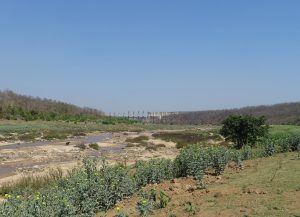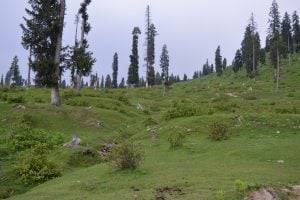The agrarian economy in South Asia supports nearly 1.2 billion people, and it is currently critically dependent on the use of groundwater. This is leading to a serious threat to the region as the water table falls under the pressure of agriculture, which in turn undermines limits how well the region manages to adapt to the impacts of climate change. At a recent conference, scientists, experts, activists and policymakers agreed that better management and governance of the groundwater is key to ensuring sustainable development.
The conference was organized by the government of India in collaboration with the International Water Association (IWA) and the World Bank on from 1-3 June 2016 in the Indian state of Rajasthan. It focussed on the water future of Afghanistan, Bangladesh, Bhutan, India, Nepal, Pakistan and Sri Lanka, and was attended by senior officials. The conference has led to the creation of a South Asian Groundwater Forum, with representatives from all the countries involved.
Long-term effects of Green Revolution
As much as 48% of groundwater in the world is used by these countries. India, Pakistan and Bangladesh are the first, fourth and sixth largest users of groundwater in the world respectively. Groundwater usage has not been historically this high. It was only in the mid-1960s that the Green Revolution took off in developing countries. Driven by heavy use of water and fertilisers, “yields for all developing countries rose 208% for wheat, 109% for rice, 157% for maize, 78% for potatoes, and 36% for cassava” between 1960 and 2000.
Although this greatly improved food security for the people living in these countries, the continued heavy use of groundwater now has now led to contamination by toxic substances, changes in soil structure and the lessening of the chances of river recharge.
At the conference, the participants agreed that groundwater levels in the region were already in a ‘deplorable condition’ due to unplanned withdrawals. However, if well managed, groundwater in South Asia can act as a powerful climate adaptation option and a natural insurance mechanism, they said. “The government cannot tackle the crisis alone, we have to engage in participatory, multi-sectoral approaches to manage the groundwater use and its impacts,” India’s junior water minister Sanwar Lal Jat said.
Rafik Hirji, World Bank team leader for the South Asian groundwater forum, said that the volume of groundwater in the upper 200m of the Indo-Gangetic basin alluvial aquifer is estimated to be 30,000 square kilometres. This is 20 times higher than the combined annual flow of South Asia’s great rivers the Indus, Brahmaputra and the Ganges.
Groundwater is a vast and vital resource for millions of people in South Asia, who depend on it for irrigation, domestic and industrial use. It can provide a reliable, drought-resilient, decentralized and usually high quality water supply to meet the rural, urban, industrial, irrigation and livestock demands.
Unfortunately, it has not been well managed. Per capita water availability continues to decline in South Asia, and the region’s water-intensive economies have increasingly turned to groundwater to supply drinking water and water for agriculture to serve a rapidly growing population. The UN World Water Development Report (WWDR 2015) claims that by 2050, agriculture will need to produce 60% more food globally and 100% more in developing countries, including South Asia.
Challenges of community management
Criticizing indiscriminate groundwater extraction, Tushaar Shah from the International Water Management Institute (IWMI) said, “Democratization of energy grid independence creates a formidable challenge for groundwater management”.
Today the solar pump is set to transform the architecture of South Asia’s groundwater economy. However, he said, the solar pumps thoughtlessly promoted today will accelerate depletion of groundwater like never before. “The only practical way to make solar pumps benign is to connect them to the grid, net-meter them and offer irrigators a long term buy-back contract for surplus solar energy,” he added.
The World Bank’s senior director for Water Global Practice, Jennifer Sara emphasised the need for community-based groundwater management. More attention is needed to address water-energy-food nexus issues by protecting recharge areas and promoting demand management and the management of both surface and groundwater, she added.
Political challenges
The participants identified a number of political challenges which need to be addressed for groundwater governance. It observed increased scientific understanding could not yet make a significant influence on resource policy making. The issue of groundwater has not been featured prominently in regional or national water policy dialogues and the focus of those dialogues are still limited to groundwater development stead of its management. The participants felt that underfunding of cooperative mechanisms also undermined cooperation.
The creation of the South Asia Groundwater Forum would hopefully be the first step in overcoming these differences. “This meeting provides a very special opportunity to find solutions for South Asia’s dwindling groundwater reserves. Today’s reality of water scarcity and drought are the future for much of the world,” said Ger Bergkamp, Chief Executive, International Water Association.
He said international cooperation on groundwater management will be fundamental to address the serious threat posed by water scarcity to communities, agriculture, industry and the environment.
The real test for the forum will be, of course, in what they manage to do, and although this is a creditable first step, regional cooperation mechanisms in South Asia have, so far, been high on rhetoric and low on delivery.
![<p>Excessive use of groundwater for agriculture is creating a crisis [image by Shahzada Irfan]</p>](https://dialogue.earth/content/uploads/2016/06/Tubewell.jpg)






